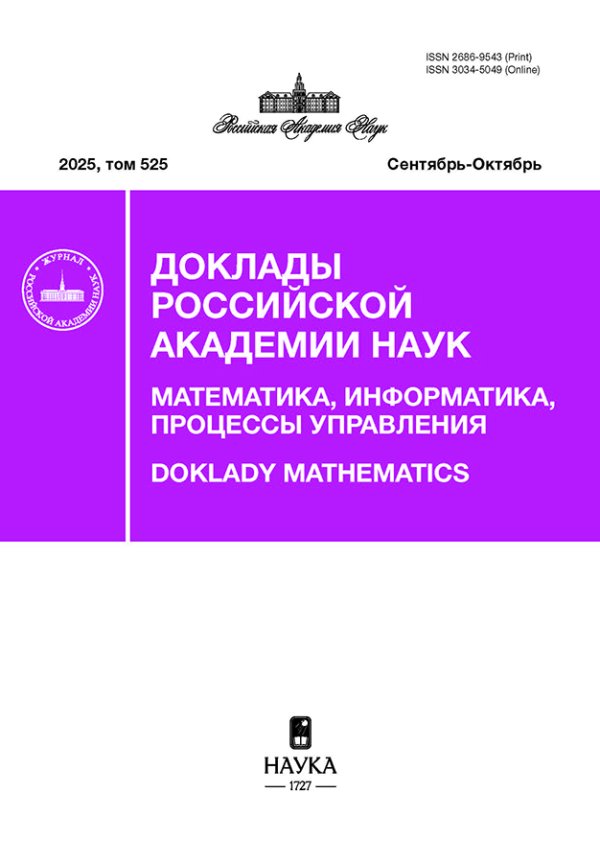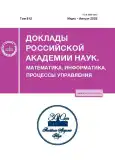О ПОИСКЕ НАЧАЛЬНОГО ПРИБЛИЖЕНИЯ В ЗАДАЧЕ ВОЛНОВОЙ ИНВЕРСИИ С ПОМОЩЬЮ СВЕРТОЧНЫХ НЕЙРОННЫХ СЕТЕЙ
- Авторы: Петров И.Б.1, Станкевич А.С.1, Васюков А.В.1
-
Учреждения:
- Московский физико-технический институт (национальный исследовательский университет)
- Выпуск: Том 512, № 1 (2023)
- Страницы: 58-64
- Раздел: МАТЕМАТИКА
- URL: https://journals.rcsi.science/2686-9543/article/view/139277
- DOI: https://doi.org/10.31857/S2686954322600732
- EDN: https://elibrary.ru/SWNWFX
- ID: 139277
Цитировать
Полный текст
Аннотация
В работе рассматривается вопрос о выборе начального приближения при решении задачи восстановления распределения скоростей в гетерогенной сплошной среде с помощью методов градиентной оптимизации. Для описания поведения среды используется система уравнений акустики, для решения прямой задачи используется конечно-разностная схема. В качестве метода градиентной оптимизации используется L-BFGS-B. Для вычисления градиента функционала ошибки по параметрам среды используется метод сопряженных переменных состояния. Построение начального приближения для градиентного метода выполняется при помощи сверточной нейронной сети, обученной предсказывать распределение скоростей в среде по волновому отклику от нее. В работе показано, что нейронная сеть, обученная на откликах от простых слоистых структур, может быть успешно использована при решении задачи инверсии для существенно более сложной модели Мармузи.
Об авторах
И. Б. Петров
Московский физико-технический институт (национальный исследовательский университет)
Автор, ответственный за переписку.
Email: petrov@mipt.ru
Россия, Московская обл., Долгопрудный
А. С. Станкевич
Московский физико-технический институт (национальный исследовательский университет)
Email: a.vasyukov@phystech.edu
Россия, Московская обл., Долгопрудный
А. В. Васюков
Московский физико-технический институт (национальный исследовательский университет)
Автор, ответственный за переписку.
Email: a.vasyukov@phystech.edu
Россия, Московская обл., Долгопрудный
Список литературы
- Tarantola A. Inversion of seismic reflection data in the acoustic approximation // Geophysics. 1984. V. 49. № 8. P. 1259–1266.
- Ovcharenko O., Kazei V., Peter D., Alkhalifah T. Variance-based model interpolation for improved full-waveform inversion in the presence of salt bodies // Geophysics. 2018. V. 83. № 5. P. R541–R551.
- Sun H., Demanet L. Extrapolated full-waveform inversion with deep learning EFWI-CNN // Geophysics. 2020. V. 85. № 3. P. R275–R288.
- Li H., Schwab J., Antholzer S., Haltmeier M. NETT: solving inverse problems with deep neural networks // Inverse Problems. 2020. V. 36. № 6. P. 065005.
- Kothari K., de Hoop M., Dokmani’c I. Learning the Geometry of Wave-Based Imaging // Advances in Neural Information Processing Systems. 2020. V. 33. P. 8318–8329.
- Gahlmann T., Tassin P. Deep neural networks for the prediction of the optical properties and the free-form inverse design of metamaterials // Phys. Rev. B. 2022. V. 106. № 8. P. 085408.
- Adler A., Araya-Polo M., Poggio T. Deep Learning for Seismic Inverse Problems: Toward the Acceleration of Geophysical Analysis Workflows // IEEE Signal Processing Magazine. 2021. V. 38. № 2. P. 89–119.
- Yang F., Ma J. Deep-learning inversion: a next generation seismic velocity-model building method // Geophysics. 2019. V. 84. № 4. P. R583–R599.
- Mast T.D., Hinkelman L.M., Metlay L.A., Orr M.J., Waag R.C. Simulation of ultrasonic pulse propagation, distortion, and attenuation in the human chest wall // Journal of the Acoustical Society of America. 1999. V. 6. P. 3665–3677.
- Golubev V., Shevchenko A., Khokhlov N., Petrov I., Malovichko M. Characteristic Scheme for the Acoustic System with the Piece-Wise Constant Coefficients // International Journal of Applied Mechanics. 2022. V. 14. № 2. P. 2250002.
- Levander A.R. Fourth-order finite-difference P-SV seismograms // Geophysics. 1988. V. 53. № 11. P. 1425–1436.
- Martin R., Komatitsch D., Ezziani A. An unsplit convolutional perfectly matched layer improved at grazing incidence for seismic wave propagation in poroelastic media // Geophysics. 2008. V. 73. № 4. P. T51–T61.
- Paszke A., Gross S., Massa F., Lerer A., Bradbury J., Chanan G., Killeen T., Lin Z., Gimelshein N., Antiga L., Desmaison A., Kopf A., Yang E., DeVito Z., Raison M., Tejani A., Chilamkurthy S., Steiner B., Fang L., Bai J., Chintala S. PyTorch: An Imperative Style, High-Performance Deep Learning Library // Advances in Neural Information Processing Systems 32. 2019. P. 8024–8035.
- Li D., Xu K., Harris J.M., Darve E. Coupled Time-lapse Full Waveform Inversion for Subsurface Flow Problems using Intrusive Automatic Differentiation // 2019. arXiv: 1912.07552.
- Xu K., Li D., Darve E., Harris J.M. Learning Hidden Dynamics using Intelligent Automatic Differentiation // 2019. arXiv: 1912.07547.
- Byrd R.H., Nocedal J., Schnabel R.B. Representations of quasi-Newton matrices and their use in limited memory methods // Mathematical Programming. 1994. V. 63. № 1. P. 129–156.
- Plessix R.-E. A review of the adjoint-state method for computing the gradient of a functional with geophysical applications // Geophysical Journal International. 2006. V. 167. № 2. P. 495–503.
- Ronneberger O., Fischer P., Brox T. U-Net: Convolutional Networks for Biomedical Image Segmentation // CoRR. 2015. V. abs/1505.04597. arXiv: 1505.04597.
- Vasyukov A.V., Nikitin I.S., Stankevich A.S., Golubev V.I. Deep convolutional neural networks in Seismic Exploration problems // Interfacial Phenomena and Heat Transfer. 2022. V. 10. № 3. P. 61–74.
- Brougois A., Bourget M., Lailly P., Poulet M., Ricarte P., Versteeg R. Marmousi, model and data // EAEG Workshop – Practical Aspects of Seismic Data Inversion. 1990.
Дополнительные файлы















